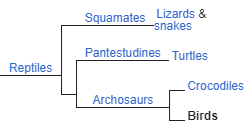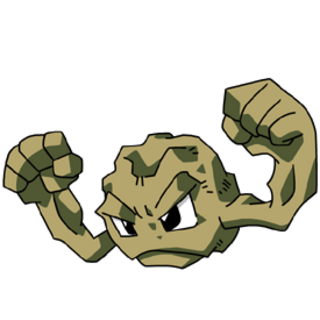When I was a kid, I learned about Dinosaur being “giant lizard”, and it’s been may-be 10 years, that I hear “Birds are dinosaurs”.
I am curious on how the concept evolve, both among paleontologists, and among the general public.
As I understand it, it’s due to advances in the technology that supports biology and paleontology. When all scientists had to go on were fossils, the bone structure of dinosaurs more closely resembled giant lizards, so thats the conclusion they came to. But recent techniques, including genetic analysis on currently existing species, clearly shows the link between birds and dinosaurs. (And, in fact, alligators are more closely related to birds than they are to lizards.)
I found this article which seems to explain it well:
https://www.scientificamerican.com/article/how-dinosaurs-shrank-and-became-birds/
It’s really weird to think I put out feed to attract the colorful cousins of alligators to my back yard.
alligators are more closely related to birds than they are to lizards.
Well that’s a cool TIL
Thank you for actually providing an explanation beyond stating the word “science”
Or heres a good youtube channel/ vid on it that goes into detial
Or if your interested in paleontology discoverys/theorys they also do monthy reviews about new papers that have came out! And i feel like raptor chatter explains it simple enough to me to understand even with no background in the field 😅
It’s both!
Triassic: Giant Lizards --> Cretaceous: Giant Birds
All birds are reptiles
Haha, no. Birds aren’t even real.
All dinosaurs are reptiles, including birds. The major clade of dinosaurs to which birds belong is called theropods. The other well-known dinosaurs, sauropods (including all the huge quadrupedal herbivores), are totally extinct and have only very distant ancestry with birds and other reptiles.
By the way, crocodilians have been around for 250 million years, so they shared the earth with the huge dinosaurs of old! But they are not dinosaurs themselves.

Wow, I had no idea.
This is fairly recent bird lore. Like late 80s to 90s. It takes a while for schools to catch up so I missed it as well.
gasp and they were squamates
I saw some documentary that suggested that they used to chip straight through fossilized feathers and skin to get to the bones because they didn’t realise what they were.
Do you remember the name? I haven’t watched a dinosaur documentary in many years.
Sorry, I don’t.
The idea is quite old:
Shortly after the 1859 publication of Charles Darwin’s On the Origin of Species, the British biologist Thomas Henry Huxley proposed that birds were descendants of dinosaurs. He compared the skeletal structure of Compsognathus, a small theropod dinosaur, and the “first bird” Archaeopteryx lithographica (both of which were found in the Upper Jurassic Bavarian limestone of Solnhofen). He showed that, apart from its hands and feathers, Archaeopteryx was quite similar to Compsognathus.
But having fossil evidence is quite young:
One of the earliest discoveries of possible feather impressions by non-avian dinosaurs is a trace fossil (Fulicopus lyellii) of the 195–199 million year old Portland Formation in the northeastern United States. Gierlinski (1996, 1997, 1998) and Kundrát (2004) have interpreted traces between two footprints in this fossil as feather impressions from the belly of a squatting dilophosaurid.
It’s too bad T.H. Huxley was such a racist POS. He was a great paleontologist and I like his style of agnosticism.
I just read his Wikipedia page. Under the conditions of his time, how was he a racist? The article says he opposed slavery, opposed “scientific racists” of the time who argued polygenism and that some races were “transitional” between animal and man, and he asserted that science could never excuse the atrocities of slave owners.
He did have incomplete theories about a racial hierarchy of intelligence, which was a common idea at the time. The article doesn’t suggest that he was a primary champion of that theory, or that it heavily featured in most of his work.
In my opinion, he seems like a man who was doing what he could to expand his understanding of his observations, even if he was limited and misled by the prevailing methods and attitudes of his lifetime. Perhaps he should be judged against his peers rather than modern sensitivities, particularly without any evidence of malice in his work.
You’re right, and he softened his stance with age (as well as his stance on sexism). To add to it on a personal level, I also enjoy the works of H.P. Lovecraft and he was wildly racist even compared to his peers.
It’s less about judging him by today’s standards than it is about lamenting that I’ll never be able to think of his work without remembering his racist views. I also can’t watch Call Girl of Cthulhu without remembering Lovecraft’s cat’s name. I can separate the art and science from the artist and scientist, especially if they’re dead so that they can’t benefit from it, but because of my own past (I was raised with a lot of passive racism by well meaning people) I can’t forget what they said.
Science!
Science got rid of Pluto as a planet tho. 😭
Pluto wasn’t demoted. It didn’t get a pay cut or see a loss of benefits.
Our vocabulary has gotten richer and more specific as we’ve explored Pluto and things like it. As we launch missions like New Horizons out there, we’re going to need new terms to talk about the things we find. We sent a whole probe to Pluto; Uranus and Neptune had to share.
I don’t think that is quite accurate.
We discovered many more Pluto-or-larger sized things that were closer to the sun than Pluto. It became increasingly obvious that there was nothing special about Pluto and we either needed to add hundreds of planets or “demote” Pluto.
I don’t believe that is accurate. Beside moons (which don’t orbit the sun), Pluto is the largest and closest dwarf planet.
Not the closest. Ceres is a dwarf planet inside the asteroid belt between Mars and Jupiter.
Holy shit science vanished a whole dwarf planet that’s insane 😱
Jurassic Park in fucking 1993 has a scene where Alan Grant messes with an annoying kid, and he clearly tells the audience that they are similar to God damn birds, you silly goose. You are that kid in the film in real life.
It’s not X turning into Y when it comes to evolution. There were all kinds of different dinosaurs, that evolved I to all kinds of different niches. Most of those then went extinct due to rocks falling from the sky, or the entirety of India turning into a huge volcano etc.
So it’s not that a T-Rex turned into a chicken, it’s that T-Rexs lived alongside other dinosaurs that developed feathers and filled more niches etc. those that survived eventually became birds. (Have you ever seen an Emu up close?!? No wonder the Australians lost to them 🤣)
Disclaimer: I have no specific knowledge. Also, remember this happened over (
billions?hundreds of millions) of years.Other comments about just not noticing feathers are valid too.
*over 100s of Millions, but what’s an extra zero amongst Internet friends
Ugh, life took ages to get started. Lazy bacteria!
It’s still a hell of a long time if you consider that the entirety of recorded (ish) history is only a few thousand years long.
Updated comment to remove an order of magnitude.
Approximately four and a half billion years ago, some rocks and shit became friends and hugged each other so tight that they created the earth.
After a few hundreds of millions of years, life appeared on earth.
Then, four-ish billion years later, Nyasasaurus was like, “roar y’all.”
And now there are birds. They’re like, “caw y’all,” and we’re all like, “yo, that’s a bird.” Then the lizards are like, “me too bro.”
The end.
You think emus look prehistoric, take a look at our cassowary!
it’s not that a T-Rex turned into a chicken
As a chicken owner, I can assure you chickens absolutely are tiny T-Rexes. Tiny, ferocious, bloodthirsty little T-Rexes that poop everywhere.
or the entirety of India turning into a huge volcano etc.
Er, I’m . . what?
I was more thinking https://en.m.wikipedia.org/wiki/Deccan_Traps
More than 1 million cubic kilometres of lava. Enough gasses to cause a mass extinction event.
Ah, well that makes sense too
Not a paleontologist, but I think it’s a mix of both wrong information being spread back then and also new info being discovered.
I’m pretty sure people knew that birds were dinosaurs for a while, but people just liked the idea that dinosaurs were monstrous lizards. Giant monsters just capture the imagination in a way that giant birds can’t.
And then paleontologists started finding fossils that had imprints of feathers still on the body, and it became really hard to ignore that dinosaurs were a lot more bird-like than people would like to believe.
My impression has generally been that once dinosaurs started to be viewed as bird-like, people started to see them as animals rather than as monsters, and that just kinda snowballed into dinosaurs becoming more and more bird-like
Science
Everyone wants a cool origin story I guess.
Also we moved from “that looks similar-ish” to analysis of fossiles and their evolution + genetic research.
But I, and thats a fact, know very little about that, and come from times when dinosaurs did not wear any fancy feathers.
A large part of the confusion is that dinosaurs did not emerge from birds in the same way that humans did not evolve from Chimpanzees (nor monkeys) - but rather, both groups in those pairs evolved from a common ancestor (but different ones:-).
Birds have feathers and for the most part fly, while alligators not so much. In attempting to simplify, e.g. Avians to “birds”, it causes confusion. Alligators also are not warm-blooded as birds are, not do they have beaks, all hallmarks of modern birds, but they do have four legs, long body with a tail, moveable eyelids - and don’t they have external ear openings as well? - all hallmarks of modern lizards.
Scientists use precision language like “non-Avian theropod”, but those don’t map perfectly to common words like “birds”, which everyone knows are just government drones anyway:-P.
Government drones aren’t real!
Birds are reptiles.
I remember in my childhood in the 90s reading it as a possibility. So it was already on people’s radar. And as far as I know in the book Jurassic Park they do have feathers. Haven’t watched the newer movies, but I heard that in Jurassic World it was explained by the frog DNA that they didn’t have feathers.
I’m pretty sure Jurassic Park (the movie) coming out was when it became common knowledge to the general public. A few hardcore dinosaur nerds (and readers of the Jurassic Park novel) were generally aware beforehand, but it was the movie that pushed it into common knowledge. (Source: I was 14 when Jurassic Park (the movie) came out)
I saw an interesting thing where they wanted that raptor chase scene, but raptors are only knee height, which isn’t very intimidating. Then, while filming, someone discovered a raptor skeleton that was human sized, so they took it. It apparently didn’t look anything like the ones in the movie, but they really wanted it and had an excuse to use it.
Was that the Urahraptor? Discovered in 1993, estimated 5-6ft tall and 16-20ft long according to wiki
















